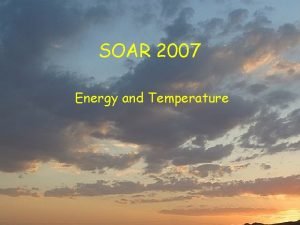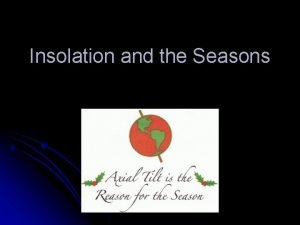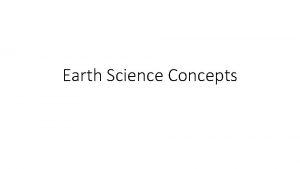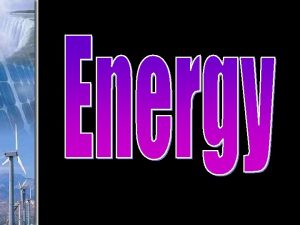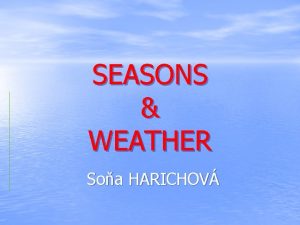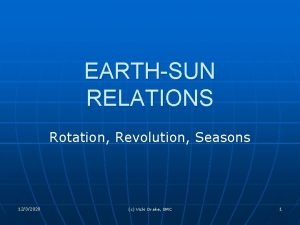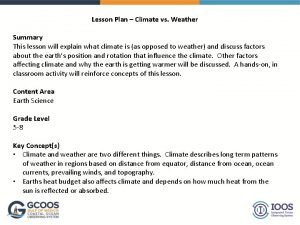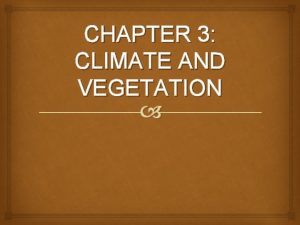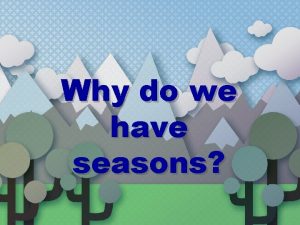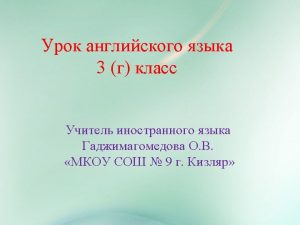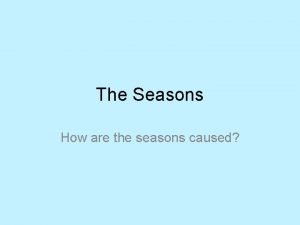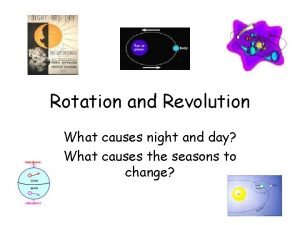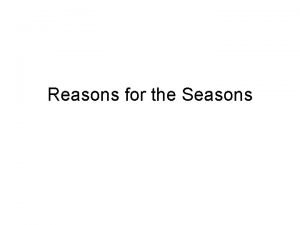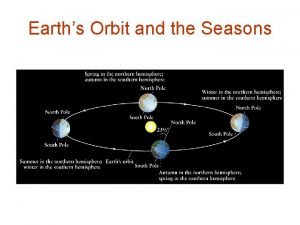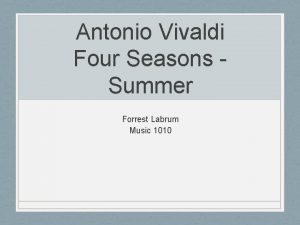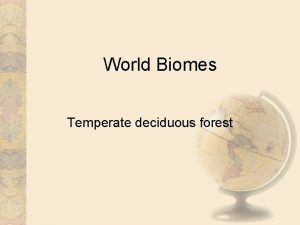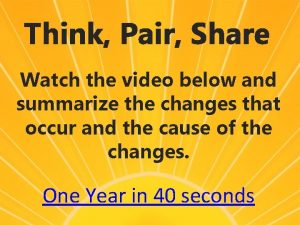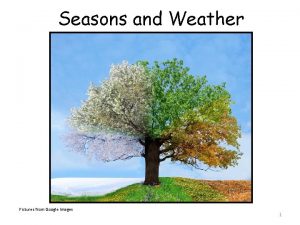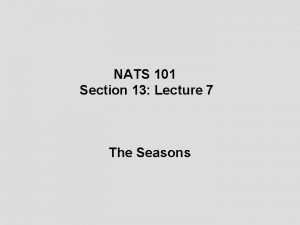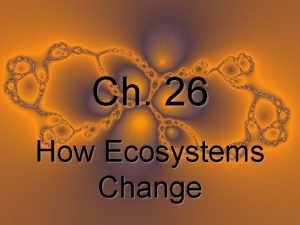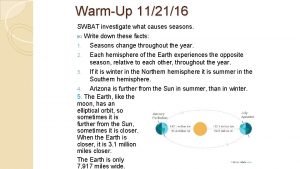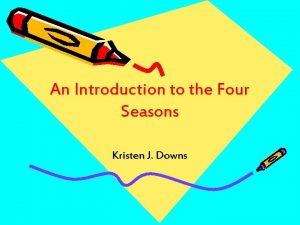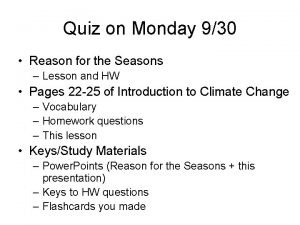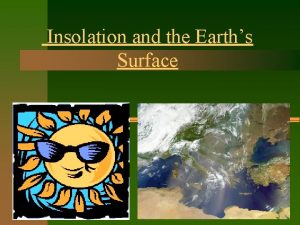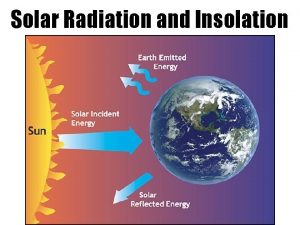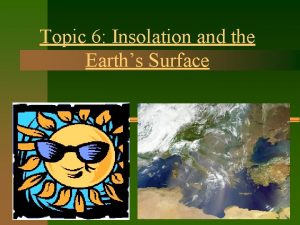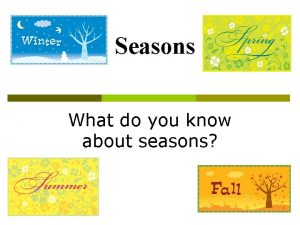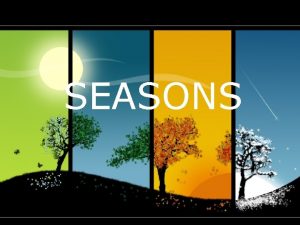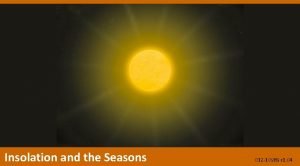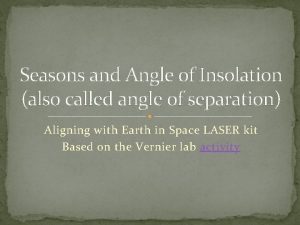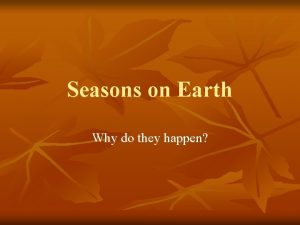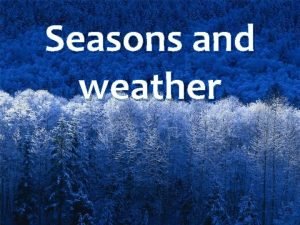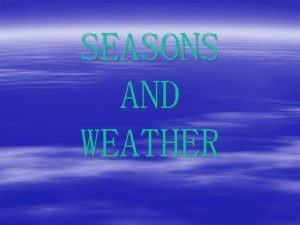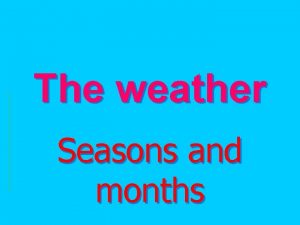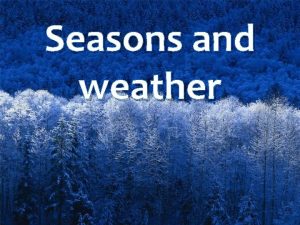INSOLATION AND THE SEASONS NOTE PACKET 6 1

































































































- Slides: 97

"INSOLATION AND THE SEASONS” NOTE PACKET #6 1

Of all the energy that hits our upper atmosphere, only a fraction reaches the surface. 2

6 -1) SOLAR RADIATION AND INSOLATION insolation - (incoming solar radiation) Øthe sun's energy that is received by Earth. Ømaximum intensity occurs as visible light. 3

Effects of Earth's Atmosphere on Insolation Ø Insolation may be … 1) absorbed, 2) reflected, or 3) scattered before it reaches the Earth's surface. 4

1 - ABSORPTION SHORT WAVE ENERGY… Most of the short wave radiation is … absorbed by the atmosphere. Ø Ultraviolet (UV) radiation is … absorbed by the ozone layer. 5

ozone Ø form of oxygen gas. (03) 6

It is being destroyed by chlorofluorocarbon Our earth will not be able to sustain life (CFC’s) gases. without the ozone layer. The ozone Ø layer has been depleting at an alarming level in recent years. The cause of ozone deletion is release of Chlorofluorocarbons in the atmosphere. Chlorofluorocarbons break down the ozone molecules punching holes in the atmosphere. The Chlorofluorocarbons are expelled into the atmosphere by: • • • Refrigeration Aerosol spray cans Air conditioning Foam insulation Cleaning agents Packing material etc 7

The 1987 Montreal Protocol and other regulations banned CFCs. Stratospheric levels of harmful CFCs will take between 40 and 100 years to dissipate and have only dropped a few per cent since reaching a peak in 2000, scientists warn. We don't expect a full recovery of Antarctic ozone until the second half of the century. " John Vidal Tuesday November 4 2008 Guardian Unlimited © Guardian Newspapers Limited 2008 8

Ozone hole in North America during 1984 (abnormally warm reducing ozone depletion) and 1997 (abnormally cold resulting in increased seasonal depletion). Source: NASA 9

NASA projections of stratospheric ozone concentrations if chlorofluorocarbons had not been banned. 10

Ø less ozone = more UV radiation striking the Earth's surface. 11

Ø UV radiation causes skin cancer. One undisputed effect of long-term sun exposure is the premature aging of the skin. Even careful tanning kills skin cells, damages DNA and causes permanent changes in skin connective tissue which leads to wrinkle formation in later life. There is no such thing as a safe tan. Also causes genetic damage, and possible eye damage 12

According to the World Health Organization, brief exposure to UV radiation, about 5 -15 minutes twice a week, is beneficial in helping the body produce vitamin D. However, the amount of exposure needed depends on several factors, including where you live, the time of day, and the time of year. 13

LONG WAVE ENERGY…. Is absorbed by greenhouse gases. Greenhouse gases; Ø carbon dioxide Ø water vapor Ø methane gas 14

2 - REFLECTION & SCATTERING Øclouds reflect insolation back into space. Øaerosols reflect, scatter, and absorb insolation. 15

aerosol Øfinely dispersed solids and liquids in the air. examples; ice crystals, water droplets, dust, volcanic ash, & pollution. 16

As the amount of aerosols increases… Ø more insolation is scattered… Ø the amount of insolation reaching the ground is less… Ø the temperature will decrease. Space Shuttle (Mission STS 43) photograph of the Earth over South America taken on August 8, 1991, showing double layer of Pinatubo aerosol cloud (dark streaks) above high cumulonimbus tops. 17

diagram 18

Balance of Energy Øthe amount of energy from insolation is equal to, the amount of energy radiated from the Earth. Øtherefore, Earth's temperature and heat are balanced. 19

DATE Main Ideas and Supporting Details 20

Factors Affecting Absorption and Reflection at Earth’s Surface. 21

1 - Angle of Insolation (angle of incidence) ØThe angle at which the insolation strikes Earth's surface. 22

The greater the angle of insolation… Ømore energy is absorbed and Ø less energy is reflected. 23

The higher the sun is in the sky, the greater the angle of insolation. 90 24

noon = sun almost overhead = large angle of insolation. high angle energy focused on small area intense heating 25

early morning or late evening = low in sky = low angle of insolation. low angle energy spread over a large area less heating 26

2 - Surface Characteristics. Texture and color… Ørough surfaces and dark colors absorb more insolation. 27

3 - Change of State and Transpiration When energy is involved in change of state or transpiration…. Øit is not available to raise the temperature of Earth's surface. 28

4 - Land vs Water ØLiquid water will heat up and cool off more slowly than an equal area of land. 29

4 Reasons why Water heats more slowly than land. 1) water has a higher specific heat. 2) insolation can penetrate water (it only heats the surface of the land). 3) water can flow, so energy can be distributed by convection currents. 4) energy is used to evaporate water. 30

DATE Main Ideas and Supporting Details 31

THE GREENHOUSE EFFECT Ø infrared energy, from the Earth, is absorbed by gases in the atmosphere. greenhouse gases = carbon dioxide, water vapor and methane. Ø Greenhouse gases reduce the amount of energy that is lost to space. Ø If less energy is lost, Earth's atmosphere becomes warmer. Ø As more of these gases are added to the atmosphere, more energy is absorbed (“global warming”). 32

Greenhouse Effect Diagram ØShort-wave radiation (insolation) passes through the atmosphere…, ØLong-wave radiation from the Earth (terrestrial radiation) is absorbed by the atmosphere. diagrams 33

greenhouse SO IN SUN N O TI LA LONG WAVE ENERGY TRAPPED INSIDE 34

Earth SUN IN ON TI LA SO Gases absorb Energy temp increases WARMS SURFACE 35

Global Warming Ø an increase in average Earth temperatures. Caused by… Ø the burning of wood and fossil fuels. Results. . Ø rising sea level. Ø shifting of climatic zones. Ø extinctions. 36

6 -2) VARIATION IN INSOLATION 37

Insolation can vary in 2 ways; 1. intensity (strength). 2. duration (length of time) 38

Five factors that affect Intensity intensity – the rate at which solar energy is received. 39

1) Angle of Insolation At 90 o (perpendicular) =maximum intensity (energy is concentrated). small area 40

At angles close to 0 o = minimum intensity (energy is spread out). large area 41

2) Earth's Shape Ø At any given time, there is only one location where the angle of insolation is 90 o. (maximum intensity) SUN’S RAYS 42

Ø For every degree of latitude, N or S of that location, the angle of insolation is one degree less. (intensity is less) Examples… 43

Example a What is the altitude of the noon sun, at Buffalo NY on March 21? Sun is directly overhead at the equator (0 o) Latitude of Buffalo NY is ~ Difference in latitude 43 o. N Difference in altitude 43 o 90 – 43 = 47 o Altitude 44

Example b What is the altitude of the noon sun, at Buffalo NY on Dec 21? Sun is directly overhead at 23. 5 o S Latitude of Buffalo NY is ~ 43 o. N Difference in latitude Difference in altitude 66. 5 o 90 – 66. 5 = 23. 5 o Altitude 45

DATE Main Ideas and Supporting Details 46

3) Latitude. Ø The maximum intensity of insolation occurs near the equator. Ø At the equator, the noon sun is always close to zenith. Ø Minimum intensity at the poles. Ø At the poles, the sun is never close to the zenith. 47

4) Time of year (Seasons) 48

SPRING March 21 Equinox SUMMER WINTER SUN Dec 21 June 21 Solstice FALL Sept 23 Equinox 49

Equinox (March 21 & Sept 23) Maximum intensity of insolation is at… 0 o Latitude (the equator). Duration = 12 hours light and 12 hours of darkness, everywhere. diagram; 50

day Sun’s rays noon sun at zenith equator night 0 o 51

52

Summer Solstice (June 21) "first day of summer" Maximum intensity of insolation is at … 23 1/2 o N Latitude (Tropic of Cancer). Duration… North Pole, 24 hours of daylight. South Pole, 24 hours of darkness. 53

day night 90. 0 o -23. 5 o 66. 5 Sun’s rays noon sun at zenith ½ 6 6 3½ o N 2 equ o. N o 0 r o t a 54

55

Winter Solstice (December 21) "first day of winter“ Maximum intensity of insolation is at… 23 1/2 o S Latitude (Tropic of Capricorn). Duration Ø South Pole, 24 hours of daylight. Ø North Pole, 24 hours of darkness. 56

day night 66 equ Sun’s rays ato noon sun at zenith 23 ½ 66 ½ o N r o 0 o S ½ o S 57

58

5) Time of Day Maximum angle and intensity of insolation occurs… Ø at solar noon. 59

Variation in Duration of Insolation duration = amount of time. Øtime between sunrise and sunset. Mean daily insolation (in W m 2) on a horizontal surface at the top of the atmosphere as a function of the day of the year and the latitude. White areas correspond to the polar night. 60

Duration is determined by…. Latitude and Season. In the Northern Hemisphere…… Longest day of the year. Summer Solstice = (June 21) 61

Shortest day of the year… ØWinter Solstice = (December 21) 62

12 hours daylight & 12 hours dark… ØSpring & Fall Equinox = (March 21 & Sept 23) 63

Relationship of Surface Temperature to Insolation When energy is being gained at a greater rate than it is being lost, Earth's surface temperature …rises. Greater intensity and/or greater duration usually means greater temperature. 64

DATE Main Ideas and Supporting Details 65

Times of Maximum & Minimum Yearly Temperature. The date for maximum and minimum temperatures occurs … after the date for maximum and minimum insolation. 66

In the Continental United States… Greatest intensity of insolation occurs on June 21. The highest temperature occurs late July or early August. Reason; After June 21 the surface still receives more energy than it loses. 67

Minimum insolation occurs on… Dec. 21. Lowest temperature occurs …in late January or early February Reason; After Dec. 21 the surface still loses more energy than it receives. 68

Times of Maximum and Minimum Daily Temperature. Maximum intensity of insolation occurs at. . solar noon. The hottest part of day occurs in … mid-afternoon. 69

Minimum intensity of insolation occurs … after the sun sets. Coolest temp occurs … just after sunrise. 70

6. 3) HEAT BUDGET AND CLIMATE CHANGE. 71

Earth's heat budget is the result balance between; 1) Radiation from the sun (insolation) 2) Radiation Earth gives off to space. 72

Examples of Climate Change. 73

1) Ice Ages ice age - period when glaciers advanced into the middle latitudes. interglacial periods - warmer periods that occurred between the times of glacial advance. 74

2) El Nino and La Nina. 75

El Nino Øoccurs every two to ten years. Ø the normally cold waters of the eastern Pacific Ocean (off western South America) are replaced with warmer waters. 76

La Nina Øperiods of time when there is exceptionally cold water. El Nino and La Nina cause major climatic repercussions around the world. 77

78

3) Global Warming. Ø from the early 1980's there has been a trend of rising temperatures known as global warming. 79

DATE Main Ideas and Supporting Details 80

POSSIBLE CAUSES FOR CLIMATIC CHANGE. 81

1 - Changes in Solar Energy. Øthe sun's energy output and related sunspot activity follow an 11 year cycle. sunspot - a darker region of the sun's surface. Øwhen there are more sunspots, the sun emits 0. 1 to 1. 0 percent more energy. 82

2 - Changes in Earth's Orbit and Axis Tilt. Ø over thousands of years the tilt of Earth's axis changes a few degrees. Ø minor changes in the eccentricity of Earth's orbit. Ø if these two things occur at the same time…summers may be cooler and winters warmer. Ø these changes seem to correlate with the advances of glaciers during the Pleistocene Ice Age. 83

3 - Volcanic Eruptions • 1990 eruption of Mount Pinatubo, causes cooling of Earth's atmosphere. • addition of aerosols makes Earth's atmosphere less transparent to insolation. 84

4 - Human Causes. 85

a) desertification Ø overgrazing causes grasslands to become deserts. Sahara Desert encroach on Nouakchott, the capital of Mauritania. Ø deserts heat up faster than grasslands, so the temperature of these areas increases. 86

b) deforestation Ø insolation once absorbed by trees goes into heating Earth's surface. Ø without trees, there is less transpiration which decreases the humidity of the atmosphere and therefore there is less precipitation. Ø these areas become hotter and drier. Loggers prepare to fell an 800 -year-old red cedar in the state of Washington. 87

A burned clearing stands in grim contrast to surrounding rain forest in Brazilian cattle graze in a pasture where rain forest once stood. 88

c) Addition of greenhouse gases to the atmosphere. 89

d) urbanization Ø clearing the land of plants and trees to construct buildings. 90

6. 4) THE SEASONS. Seasonal changes result from variation in the… 1) angle of insolation. 2) intensity of insolation. 3) duration of insolation. There is little seasonal change near…. . the equator. Season changes are more extreme near …. the poles. 91

Causes for the Seasons. 92

a) Tilt of Earth's Axis. Ø Earth's axis is tilted 23. 5 o with respect to the plane of its orbit. Ø perpendicular insolation from the sun shifts between 23. 5 o N (on June 21) and 23. 5 o S latitude (on Dec 21). Ø a greater tilt would produce warmer summers and colder winters. Ø no tilt would result in no seasons. 93

b) Parallelism of Earth's Axis. Ø the position of Earth's axis at any time is always parallel to its position at any other time (parallelism). Ø the Northern end of Earth's axis always points towards the North Star (Polaris). 94

c) Revolution Around the Sun. As Earth revolves around the sun, the direction of Earth's axis with respect to the sun varies. Ø On June 21………. . the North Pole is inclined toward the sun. Ø On Dec 21………. . the South Pole is inclined toward the sun Ø On March 21 & Sept. 23… neither is inclined toward the sun. 95

The Effect of Earth's Elliptical Orbit. Øbecause the Earth's orbit is an ellipse, the distance between the Earth and the sun varies. Øthese changes are too small to have any significant affect on the seasons. Øduring Winter in the Northern Hemisphere the Earth is closest to the sun. 96

DATE Main Ideas and Supporting Details 97
 Angle of insolation lab
Angle of insolation lab Ocean current
Ocean current Insolation
Insolation Insolation of earth
Insolation of earth Whats insolation
Whats insolation Difference between note making and note taking
Difference between note making and note taking Signal words example sentences
Signal words example sentences Difference between note making and note taking
Difference between note making and note taking Draw a specimen of debit note
Draw a specimen of debit note Debit note
Debit note Note taking and note making
Note taking and note making Financial documents order
Financial documents order Simple discount note
Simple discount note Seasons and weather
Seasons and weather Summer spring winter fall
Summer spring winter fall Revolution
Revolution Northern hemisphere and southern hemisphere seasons
Northern hemisphere and southern hemisphere seasons Chapter 3 section 1 seasons and weather
Chapter 3 section 1 seasons and weather Seasons of the year song
Seasons of the year song Hát kết hợp bộ gõ cơ thể
Hát kết hợp bộ gõ cơ thể Slidetodoc
Slidetodoc Bổ thể
Bổ thể Tỉ lệ cơ thể trẻ em
Tỉ lệ cơ thể trẻ em Voi kéo gỗ như thế nào
Voi kéo gỗ như thế nào Thang điểm glasgow
Thang điểm glasgow Chúa yêu trần thế alleluia
Chúa yêu trần thế alleluia Môn thể thao bắt đầu bằng từ chạy
Môn thể thao bắt đầu bằng từ chạy Thế nào là hệ số cao nhất
Thế nào là hệ số cao nhất Các châu lục và đại dương trên thế giới
Các châu lục và đại dương trên thế giới Công thức tính độ biến thiên đông lượng
Công thức tính độ biến thiên đông lượng Trời xanh đây là của chúng ta thể thơ
Trời xanh đây là của chúng ta thể thơ Mật thư tọa độ 5x5
Mật thư tọa độ 5x5 Làm thế nào để 102-1=99
Làm thế nào để 102-1=99 Phản ứng thế ankan
Phản ứng thế ankan Các châu lục và đại dương trên thế giới
Các châu lục và đại dương trên thế giới Thể thơ truyền thống
Thể thơ truyền thống Quá trình desamine hóa có thể tạo ra
Quá trình desamine hóa có thể tạo ra Một số thể thơ truyền thống
Một số thể thơ truyền thống Cái miệng xinh xinh thế chỉ nói điều hay thôi
Cái miệng xinh xinh thế chỉ nói điều hay thôi Vẽ hình chiếu vuông góc của vật thể sau
Vẽ hình chiếu vuông góc của vật thể sau Biện pháp chống mỏi cơ
Biện pháp chống mỏi cơ đặc điểm cơ thể của người tối cổ
đặc điểm cơ thể của người tối cổ Giọng cùng tên là
Giọng cùng tên là Vẽ hình chiếu đứng bằng cạnh của vật thể
Vẽ hình chiếu đứng bằng cạnh của vật thể Fecboak
Fecboak Thẻ vin
Thẻ vin đại từ thay thế
đại từ thay thế điện thế nghỉ
điện thế nghỉ Tư thế ngồi viết
Tư thế ngồi viết Diễn thế sinh thái là
Diễn thế sinh thái là Dot
Dot Số nguyên tố là
Số nguyên tố là Tư thế ngồi viết
Tư thế ngồi viết Lời thề hippocrates
Lời thề hippocrates Thiếu nhi thế giới liên hoan
Thiếu nhi thế giới liên hoan ưu thế lai là gì
ưu thế lai là gì Hươu thường đẻ mỗi lứa mấy con
Hươu thường đẻ mỗi lứa mấy con Sự nuôi và dạy con của hổ
Sự nuôi và dạy con của hổ Sơ đồ cơ thể người
Sơ đồ cơ thể người Từ ngữ thể hiện lòng nhân hậu
Từ ngữ thể hiện lòng nhân hậu Thế nào là mạng điện lắp đặt kiểu nổi
Thế nào là mạng điện lắp đặt kiểu nổi Seasons
Seasons Why do we experience seasons
Why do we experience seasons Spring weather
Spring weather How many seasons in a year
How many seasons in a year Fall is what months
Fall is what months The wire season themes
The wire season themes Why seasons
Why seasons Clove of the seasons
Clove of the seasons Liturgical year
Liturgical year How do seasons work on earth
How do seasons work on earth Tongue twister winter
Tongue twister winter Seasons of the year in english
Seasons of the year in english Revolution rotation difference
Revolution rotation difference There are four season all over the world true or false
There are four season all over the world true or false Levinson seasons of life theory
Levinson seasons of life theory Seasons of the year earth's position
Seasons of the year earth's position Theories of adulthood
Theories of adulthood Why do we experience seasons
Why do we experience seasons What animals represent freedom
What animals represent freedom Levinson seasons of life theory
Levinson seasons of life theory Vivaldi 4 seasons summer
Vivaldi 4 seasons summer Seasons in temperate forest
Seasons in temperate forest Thevideo pair
Thevideo pair Why do we have seasons
Why do we have seasons What causes the seasons to change? *
What causes the seasons to change? * Themes in the bluest eye
Themes in the bluest eye Seasons images
Seasons images Importance of seasons
Importance of seasons Seasons wines mumbai
Seasons wines mumbai Tundra seasons
Tundra seasons What causes the seasons to change? *
What causes the seasons to change? * Kim ki duk spring summer fall winter
Kim ki duk spring summer fall winter Remember the seasons
Remember the seasons Earths orbit seasons
Earths orbit seasons Winter spring summer fall there are seasons four in all
Winter spring summer fall there are seasons four in all Skip through the seasons
Skip through the seasons The seasons
The seasons

